|
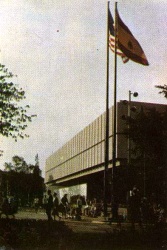
- The U.S.A and the Spanish
Flags
- hoisted above the Pavilion.
-
-
-
-
-
-
-
- REPORT
- OF THE
- FIRST PERIOD
- The permanent representative
of Spain at the United Nations, Don Manuel Aznar, stated publicly
that the future of all kinds of relations between the Untied
States and Spain would have to be conditioned before the Pavilion
and after the Pavilion. This statement which may seem exaggerated
to some, is nothing more than the recognition of a Spanish success
such as has never before been known in New York. The Pavilion
of Spain comprised such an outstanding sum of quantities and
qualities on the occasion of this international exhibition that
the Pavilion was not the only victor, but all Spain.
-
- From April to October, 1964,
more has been written on Spain and published in the press of
the United States than in the ten preceding years. And all that
has been written, radioed and televised has been favorable.
|
-
THE
JEWEL OF THE FAIR
- The popular magazine Life
called our Pavilion The Jewel of the Fair and never has
there been such an exact definition, as everything in the Pavilion
had been studied, cared for, and worked over as though it were
a most splendid jewel. The warmest praises were given to the
Pavilion, the mere mention of which would fill many pages. Therefore
this banner of praise is more than sufficient: The Jewel of
the Fair.
-
-
-
The Clothed Maja.
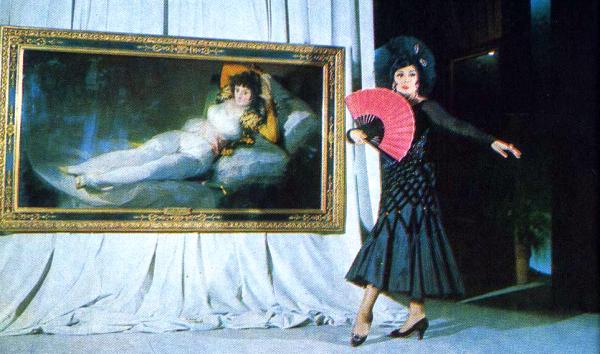 |
- If the Pavilion proved a jewel
it was not owing to chance nor to improvisation. At an alarmingly
short notice (nine months before the date fixed for the inauguration)
the General Commissioner of Spain for the New York Fair, Miguel
Garcia de Saez, announced that the New York World's Fair could
be the Fair of Spain. The object was ambitious and to some disproportionate,
but the final success proved that when one works intelligently
and with absolute faith and wholeheartedness, any aim can be
reached no matter how fantastic it may seem.
-
- So that the Pavilion of Spain
could be a reality, a limited competition was held between twenty
Spanish architects. The most outstanding and interesting figures
of present-day Spanish architecture took part with their ideas,
many of them truly original and ingenious, but not all appropriate
for building on the site of the World's Fair.
-
- After a careful scrutiny the
project presented by Javier Carvajal was chosen; as the greater
part of the project consisted of pre-fabricated pieces, it was
possible to erect the Pavilion in short time.
|
-
THE
ATTRACTIONS OF THE PAVILION
- The Pavilion of Spain offered
the visitor a complete, present-day yet eternal image of Spain,
with its principal characteristics underlined. Its art, brought
from the principal museums, with works by El Greco, Velazquez,
Ribera, Zurbaran, Murillo and Goya; collections of contemporary
art with special works by Picasso, Miro, Dali, Gris and the most
renowned contemporary young artists. Two luxury restaurants,
Toledo and the Granada considered the smartest
of the Fair by all the gastronomical experts of the New York
publications; a typical tavern, the Marisqueria Madrid,
the favorite haunt of the numerous Spanish and Latin American
colony of New York; three bars in which it is possible to taste
all kinds of Spanish wines and specialties.
|
-
Painting by Miro.
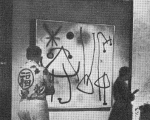 |
|
-
THE
THEATRE
- The theatre capable of seating
eight hundred persons on whose stage have appeared the principal
groups of Spanish dancers, such as the Coros y Danzas
of Bilbao, Santander, the Canary Islands, Badajoz, Granada, Murcia,
Teruel, Zamora and Barcelona; the ballets of the Zambras,
Antoinio Gades, Manuela Vargas, Mariemma, Lorquiana and
the Ballet Gallego, the Tuna (the Undergraduate musical
association) of the Pharmacy Faculty of Madrid and the guitar
player, Diaz Cano.
|
-
The Inaugural show
in the Theatre.
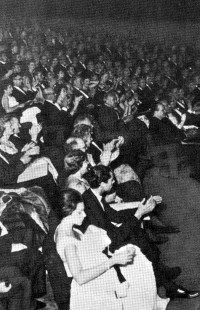 |
|
- On the same stage visitors were
shown Spanish documentaries and the film specially made for the
Pavilion: Let's meet Spain, in which a superb panorama
of the different Spanish regions and customs was shown. The Pavilion
was also a well formed unit exhibiting samples of craftsmanship,
new industries, toys, books, typical and popular furniture, perfumes,
cars, motor-cycles tourism, etc., all of which enabled one on
a detailed visit to realize the importance of Spain in the past
and in the future.
-
- Authentic and outstanding historical
artistic objects, which, for the first time, had been shown outside
Spain, heightened the value of the Pavilion: the crown and sceptre
of Queen Isabella the Catholic, the sword Tizona of the
hero El Cid, lent a note of legendary history to the elegance
and dignity of the rooms of the building.
-
- For all these reasons, the Pavilion
of Spain soon became the favorite of all the international ones
and one of the most visited of all the Fair. During the first
few days entrance was free, but in view of the crowds of visitors,
entrance was arranged by means of a ticket costing $0.25. Endless
queues formed in front of the gates of the Pavilion during the
six months of the fair.
|
- Many a time on public holidays
and their eves, the sale of tickets had to be suspended until
the Pavilion was emptied. More than ten million visitors have
passed through, looking at and praising the beauties to be found
inside the Pavilion and many of these visitors have returned
several times, eager to absorb the emotion and the variety offered.
|
-
Long queues in front
of the Pavilion.
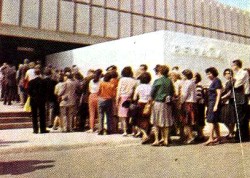 |
|
-
FASHION
AND HAUTE COUTURE
-
Fashion Show.
|
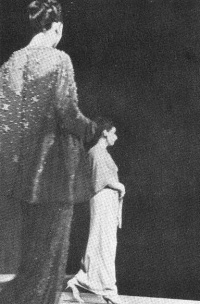
|
|
- Spanish fashion and haute couture
also had a place in the Pavilion; both masculine and feminine
for smart well-dressed occasions as for those sporting events
requiring suede and leather. Various and varied have been the
Galas given over to the important branch of industry of
the Spanish dress-making and tailoring trades.
|
-
THE
MUSEUM PAVILION
- The Pavilion of Spain forms
a real museum of both classical and in contemporary art, because
besides the works brought from museums, a whole series of young
artists prepared special works for the Pavilion, such as the
sculptors Amadeo Gabino, Pablo Serrano, Jose Luis Sanchez and
the painters Vaguero Turcios, Ferrars, Molezun and Jose Maria
de Labra, and Cumella, the ceramist. A selection was made of
over seventy of the youngest painters and sculptors, and their
works were shown in five successive exhibitions with great success
in both sales and notices.
|
- The Pavilion of Spain forms
a real museum of both classical and in contemporary art, because
besides the works brought from museums, a whole series of young
artists prepared special works for the Pavilion, such as the
sculptors Amadeo Gabino, Pablo Serrano, Jose Luis Sanchez and
the painters Vaguero Turcios, Ferrars, Molezun and Jose Maria
de Labra, and Cumella, the ceramist. A selection was made of
over seventy of the youngest painters and sculptors, and their
works were shown in five successive exhibitions with great success
in both sales and notices.
|
-
Painting by Picasso.
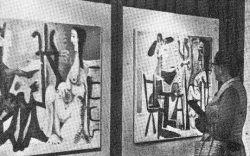 |
|
- As a special exhibition within
the Pavilion we must mention that carried out by the Owen
Cheatham Foundation of the collection of jewels designed
by Dali which belong to that Foundation. The thirty-one pieces
were exhibited for several months for charitable purposes, the
proceeds going to the Fight against Cancer. Moe than a
hundred Spanish artists have been present at the Pavilion of
Spain in the World Fair; the selection ranged from the most illustrious
masters to the youngest experimental painters. The Pavilion has
been a real museum in which millions of visitors were able to
see for themselves the strength of Spanish artistic creation
throughout the centuries.
|
-
DISTINGUISHED
VISITORS
- Among the many events that were
held in the Pavilion, the blessing of the building by Cardinal
Spellman on the 26th April was especially moving. After the blessing,
the Cardinal visited all parts of the building and stopped to
speak to all kinds of people.
|
-
Lady Johnson.
|

|
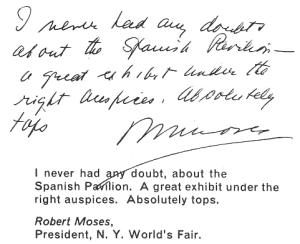 |
At the end he expressed himself
most eloquently: I have to congratulate most warmly all those
who have made this marvel of the World Fair possible; everything
in the Pavilion has been perfectly planned and carried out.
On 9th of May President Johnson's
wife visited the Pavilion and had lunch with those who accompanied
her at the Toledo restaurant. The eldest daughter of the
President also visited the Pavilion on another occasion accompanied
by her fiance. The Duke and Duchess of Windsor; the Infanta Cristina
of Borbon; President Kennedy's mother and sisters; the Sha of
Persia and his wife, the Empress Farah Diva; Mr. Wagner, the
Mayor of New York; Richard Dixon; the President of Panama, D.
Marcos A Robles; maestro Stokowsky; the dramatist, Arthur Miller;
The Secretary for State , Mr. Dean Rusk; the President of the
Republic of Costa Rica, Sr. Orlich; the Spanish Labor Minister,
Sr. Romeo Gorria; the Commanders of the signatory countries of
the OEA; the Secretary General of the United Nations, Mr. U-Thant;
the President of the Supreme Court of Justice of the U.S.A.,
Mr. Warren; the President of Nicaragua, Sr. Somoza; Cardinal
Cushing; the Spanish Minister of Information and Tourism, Sr.
Fraga. All these names of personalities are only some of the
most famous of the great number of politicians, ambassadors,
ministers, film and television stars, writers, sportsmen and
all kinds of personalities that have honored the Pavilion of
Spain with their presence.
|
-
FIESTAS
- During these six months numerous
celebrations of a special character have been held in the Pavilion.
One of the most picturesque was the Verbena of San Antonio
on the eve of June 13th, with all the popular and typical events
of such summer festivities. There were also special circumstances
that caused the attention and curiosity of the people to be fixed
in a special way on the Pavilion. The three-millionth visitor
was George K. Bird, a Massachussets teacher who visited the Pavilion
accompanied by his wile and his four children and who was splendidly
treated. The Madrid shell-fish Tavern celebrated the 75,000 paella
served on the premises. Luck fell to the North-American family
Rizor who were visiting the Pavilion for the first time. The
distinction of being the 8,000,000th visitor fell to the businessman
from Guatemala, Sr. Herrara. All these lucky people were entertained
splendidly and visited the whole Pavilion free.
-
-
-
The Tuna.
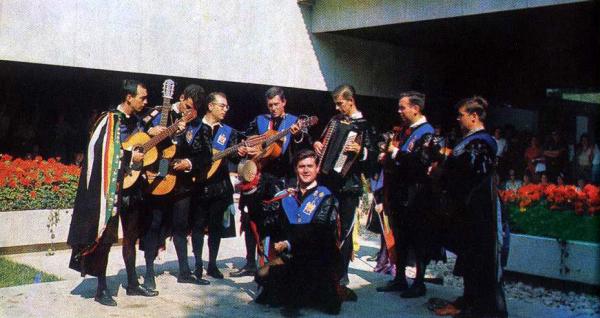 |
- One of the most moving events
was that held on June 26th in honor of the foreign representatives
of the United Nations. Almost all the representatives and ambassadors
attended the Pavilion for the Spanish Fiesta which consisted
of a gala dinner and a theatrical show of Spanish songs an dances.
For the first time since the UNO was constituted all its representatives
were gathered together at an event organized by Spain.
-
- October 12th was proclaimed
Day of Spain at the Fair. On account of this there were
different events held in which the affection of the Ibero-American
countries toward Spain became manifest and was symbolized principally
in the offerings of flowers and fruits before the statue of Queen
Isabella the Catholic which presides over the Pavilion of Spain.
|
-
CLOSING
- The closing of the Pavilion
at the end of the first stage of the Fair was most moving. The
flags which had flown for six months sided by side were stuck,
the North-American one by the Commissioner, Sr. Garcia de Saez,
and the Spanish one by an American watchman who guarded the Pavilion
at night.
-
- Thousands of newspaper articles,
of radio commentaries, of television and cinema news-reels, were
all in praise of the Pavilion of Spain.
-
-
- AMONG OTHER
- DISTINCTIONS, THE
- PAVILION HAS RECEIVED:
-
- THE GOLD MEDAL OF THE
- NEW YORK WORLD'S FAIR
-
- FIRST PRIZE OF THE
- NATIONAL SCHOOL OF
- ARCHITECTS OF THE
- UNITED STATES IN 1964
-
- GOLD MEDAL OF THE
- ASSOCIATION OF
- INTERIOR DECORATORS
-
- GOLD MEDAL OF THE
- SALMAGUNDI CLUB
-
- DIPLOMA OF HONOR OF
- THE NATIONAL ART CLUB
|
|
|
-
The closing scene.
The flags of U.S.A. and of Spain are lowered.
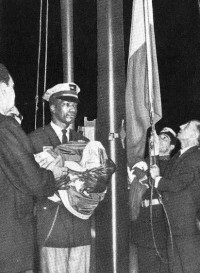 |
|

-
POSTERS OF THE PAVILION
OF SPAIN
- The Spanish Pavilion comprises
in its spiritual and material architecture a thousand different
aspects and facets manifested in its varied contents and daily
activities. Faithful image of Spain throughout the ages, the
Pavilion is a synthesis of the best to be found in a people that
makes its tradition a springboard from which to leap forward
into the revolutionary future. From the art of Tartessus to the
discovery of America, from enduring folklore to industrial mass
production, from codices and castles to tourism at all levels,
this image represents purely and simply the real Spain.
-
- A contribution towards making
this real image more widely known is provided by the varied and
attractive posters of the Pavilion of Spain.
|
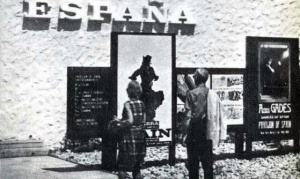
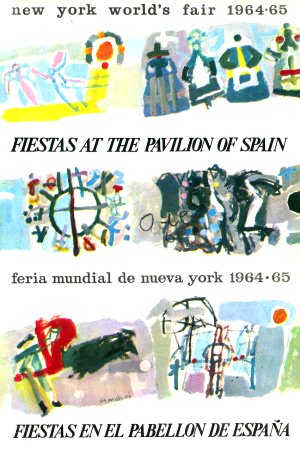
|
|
- Source: 1965 Guide
- Pavilion of Spain

|
|